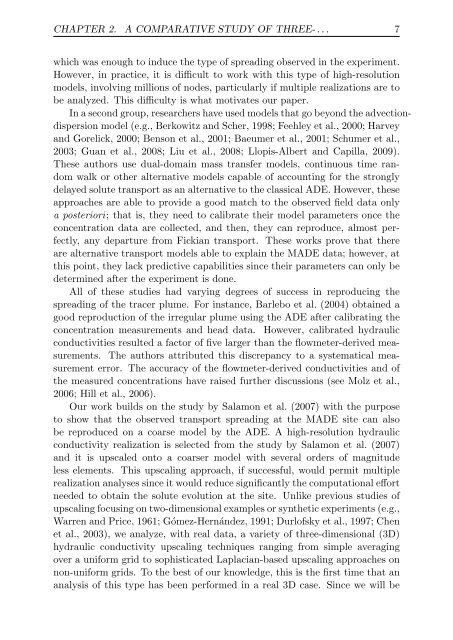Upscaling and Inverse Modeling of Groundwater Flow and Mass ...
Upscaling and Inverse Modeling of Groundwater Flow and Mass ...
Upscaling and Inverse Modeling of Groundwater Flow and Mass ...
Create successful ePaper yourself
Turn your PDF publications into a flip-book with our unique Google optimized e-Paper software.
CHAPTER 2. A COMPARATIVE STUDY OF THREE- . . . 7<br />
which was enough to induce the type <strong>of</strong> spreading observed in the experiment.<br />
However, in practice, it is difficult to work with this type <strong>of</strong> high-resolution<br />
models, involving millions <strong>of</strong> nodes, particularly if multiple realizations are to<br />
be analyzed. This difficulty is what motivates our paper.<br />
In a second group, researchers have used models that go beyond the advectiondispersion<br />
model (e.g., Berkowitz <strong>and</strong> Scher, 1998; Feehley et al., 2000; Harvey<br />
<strong>and</strong> Gorelick, 2000; Benson et al., 2001; Baeumer et al., 2001; Schumer et al.,<br />
2003; Guan et al., 2008; Liu et al., 2008; Llopis-Albert <strong>and</strong> Capilla, 2009).<br />
These authors use dual-domain mass transfer models, continuous time r<strong>and</strong>om<br />
walk or other alternative models capable <strong>of</strong> accounting for the strongly<br />
delayed solute transport as an alternative to the classical ADE. However, these<br />
approaches are able to provide a good match to the observed field data only<br />
a posteriori; that is, they need to calibrate their model parameters once the<br />
concentration data are collected, <strong>and</strong> then, they can reproduce, almost perfectly,<br />
any departure from Fickian transport. These works prove that there<br />
are alternative transport models able to explain the MADE data; however, at<br />
this point, they lack predictive capabilities since their parameters can only be<br />
determined after the experiment is done.<br />
All <strong>of</strong> these studies had varying degrees <strong>of</strong> success in reproducing the<br />
spreading <strong>of</strong> the tracer plume. For instance, Barlebo et al. (2004) obtained a<br />
good reproduction <strong>of</strong> the irregular plume using the ADE after calibrating the<br />
concentration measurements <strong>and</strong> head data. However, calibrated hydraulic<br />
conductivities resulted a factor <strong>of</strong> five larger than the flowmeter-derived measurements.<br />
The authors attributed this discrepancy to a systematical measurement<br />
error. The accuracy <strong>of</strong> the flowmeter-derived conductivities <strong>and</strong> <strong>of</strong><br />
the measured concentrations have raised further discussions (see Molz et al.,<br />
2006; Hill et al., 2006).<br />
Our work builds on the study by Salamon et al. (2007) with the purpose<br />
to show that the observed transport spreading at the MADE site can also<br />
be reproduced on a coarse model by the ADE. A high-resolution hydraulic<br />
conductivity realization is selected from the study by Salamon et al. (2007)<br />
<strong>and</strong> it is upscaled onto a coarser model with several orders <strong>of</strong> magnitude<br />
less elements. This upscaling approach, if successful, would permit multiple<br />
realization analyses since it would reduce significantly the computational effort<br />
needed to obtain the solute evolution at the site. Unlike previous studies <strong>of</strong><br />
upscaling focusing on two-dimensional examples or synthetic experiments (e.g.,<br />
Warren <strong>and</strong> Price, 1961; Gómez-Hernández, 1991; Durl<strong>of</strong>sky et al., 1997; Chen<br />
et al., 2003), we analyze, with real data, a variety <strong>of</strong> three-dimensional (3D)<br />
hydraulic conductivity upscaling techniques ranging from simple averaging<br />
over a uniform grid to sophisticated Laplacian-based upscaling approaches on<br />
non-uniform grids. To the best <strong>of</strong> our knowledge, this is the first time that an<br />
analysis <strong>of</strong> this type has been performed in a real 3D case. Since we will be


